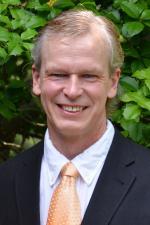
'
Lars Olson, SESYNC Sabbatical Fellow
When he began his undergraduate career at Eckerd College, Dr. Lars Olson thought he would pursue mathematics, go to graduate school, and become a professor. Young Olson wasn’t entirely incorrect—he would go to graduate school, gain a faculty position in a related field, and even serve as a department chair in his chosen profession. However, what he didn’t know was that his love of mathematics would find its expression in the field of agricultural and resource economics.
“Economics is so exciting, because you can use mathematical tools to do applied work that directly connects to policy,” he says, “You’re not just doing abstract mathematics, you’re working on important issues that are policy-relevant. The decisions made today regarding the environment impact not just current benefits and costs, but also the welfare of future generations,” he attests. “Economics helps us understand the incentives that drive decisions and how we care for the environment.”
After receiving his PhD in Economics at Cornell University in 1988, Olson worked in the Department of Environmental Science at the University of California, Riverside. This experience taught him the value of interdisciplinary science. “The department had soil and atmospheric chemists, microbiologists, soil physicists, hydrologists, and more, and then there was this small, but very collegial group of agricultural and resource economists,” he says, “It was a great introduction to interdisciplinary environmental science and how scholars from different disciplines can complement each other in mutually beneficial ways.”
Olson began working at the University of Maryland’s Department of Agricultural and Resource Economics in 1993, where he currently resides as a Professor. During this time, Olson has maintained positions as associate editor (1996-1999) and on the editorial council (1994-1995, 2001-2004) of the Journal of Environmental Economics and Management and served as chair of the department from 2008-2013. Studying a variety of issues in agricultural and resource economics—from natural resource allocation over time and under uncertainty to pollution abatement under technological change—he understands the complexity and necessity of socio-environmental synthesis to advance knowledge and promote better policy.
It is this synthetic perspective that Olson will use as a SESYNC Sabbatical Fellow through August 2017. While at SESYNC, Olson will work on a variety of projects, including studies on risk factors for invasive pests transmitted through international trade, the value of pest screening and identification services in facilitating trade, and the economics of fisheries management under correlated environmental disturbances, such as those associated with climate change. An accomplished instructor, Olson also hopes to take full advantage of SESYNC’s educational mission during his appointment. By working with SESYNC’s abundant interdisciplinary experts on multidisciplinary science and data visualization and analysis, Olson hopes to learn new methods to train students of various backgrounds on how to think about environmental problems and conduct research using socioeconomic and environmental data.
Working at the intersections of economics, science, and policy, Olson says he looks forward to the, “intellectually stimulating environment for research and scholarship” that SESYNC provides. “It is very exciting to be surrounded by an exceptional group of distinguished young scholars from different disciplines who are all interested in similar types of problems,” says Olson. “I expect I will learn much from my experience at SESYNC.”
The National Socio-Environmental Synthesis Center, funded through an award to the University of Maryland from the National Science Foundation, is a research center dedicated to accelerating data-driven scientific discovery at the interface of human and ecological systems. Visit us online at www.sesync.org and follow us on Twitter @SESYNC.